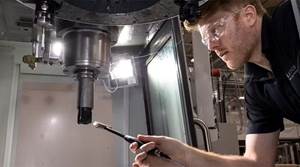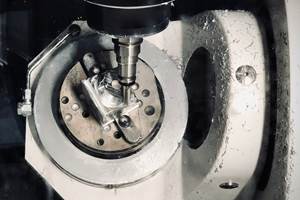Buying a Five-Axis: The Costs and Benefits of a Complex Machine
When considering transitioning to a five-axis machining center, it is helpful to understand the basics about the machines’ components, their costs and the opportunities they provide.
Share





Some companies with more complex parts should start thinking about purchasing a five-axis machine, which is often considered the natural progression from a horizontal machining center (HMC). Likewise, companies heavily into vertical machining in which a fourth-axis table or trunnion may have been added to a three-axis vertical, should also think about buying a five-axis machine.
Complex Surfaces, Complex Geometry
You may be surprised to learn that only about 5 percent of all machined parts require processing by full five-axis machines. Five-axis machining is most prevalent in the aerospace industry, where parts tend to be non-prismatic (not box-like), with complex surfaces, such as aerospace turbines, impellers or airfoil blisks. These complex designs require all five axes of the machine moving at the same time to create the shape, thus enabling the cutting tool to take a multidirectional approach to the part surface. Five-axis machining is also extensively used in moldmaking, where the need to produce complex geometry and surfaces is ever-present. Later in this article, we will cover some of the benefits of using a five-axis machine even if your parts aren’t that complex.
Processing Power
In full five-axis machining, all five axes can move and cut simultaneously. This type of machine requires highly responsive servodrives to move instantaneously while responding to thousands of move/position commands. High-accuracy rotary tables are needed to position the part precisely, despite the forces created by the cutting process.
To handle these computing tasks adequately, a machine control must have high processing power to calculate, keep track of and control the tool center point. (The tool center point is critical, because its position and orientation determine how material is removed to produce the desired shape.) Five-axis program code includes instructions for the X, Y and Z linear axes; the two rotational A and B axes working in unison to keep the tool normal (perpendicular) to the part surface when contouring; and I, J and K vectors for tool cutter offsets. This constant calculation includes all fixture offsets, tool offsets, tool cutter compensation and translation of all work planes, regardless of which axis or rotary table is moving.
To do this, the control must be able to respond instantly to the servodrives, process motion commands in blocks, and interpret large quantities of CAM data while “looking ahead” to where the tool is going next. All of this computing must be done accurately, so that no dwell marks are left on the surface of the part. Avoiding dwell marks is especially critical in mold work. This capability also enables probing to be used during the machining cycle to check the results. To support this processing power and ability, the cost of a full five-axis machine is substantially higher than three-axis machines.
Positional Machining with Five Axes
Although it may appear that the next step forward from three-axis machining is full five-axis, there’s a transitional step called 3+2 machining. This in-between mode gets the job done, but with a less-expensive machine. Just because a non-prismatic part has holes, angles or features that are not normal to the surface or machine axis does not mean that full five-axes capability is required.
To machine the necessary features with 3+2 machining, the machine tilts the tool or rotates the fourth and fifth axes to a fixed position, then executes a three-axis program, moving in X, Y and Z. This is sometimes called five-axis positional machining, rather than full five-axis machining in which the tool is continually being manipulated in all linear and rotary axes at once.
While the 3+2 control can track the initial origin of the part, it’s a somewhat slower, one-move-at-a-time process. Unlike with full five-axis control, the 3+2 control does not need to be capable of tracking the movement of all axes, translating and updating work offsets, tooling offsets and coordinate systems during the cut. With 3+2, only one work plane is computed at a time. That is, the control “thinks” of the tool moving in relationship to a flat, static surface correctly located on a certain spot on the part shape so that the tool can be perpendicular at that point. Move to the position, rotate, then cut.
Not all 3+2 machines are designed to move and cut at the same time. In this case, activities take place only in the static work plane established before cutting begins. No other machining or processing is going on during part rotation. Programming for 3+2 may require a kind of a multi-operation-by-workplane approach. The control on a 3+2 machine is not nearly as sophisticated as the control on a full five-axis machine, and the software need not be as powerful. Therefore, the initial price tag of the 3+2 machine is far lower than that of a full five-axis machine.
Increased Cost for Full Five Axis
There’s a big price difference between a full five-axis machine and a three-axis machine, and many factors contribute to this higher price. The construction and quality of the machine itself are costly. Five-axis machines are built for high precision. Ultra-precise, high-accuracy rotary tables and trunnions are essential, and these devices are expensive. With full five-axis machining, the machine’s movement is limited by the speed of the slowest rotary axis, so high-accuracy, high-speed rotary devices are installed. This is a big factor in the machine cost.
Likewise, high-performance, long-lasting spindles with high-speed capability often are used to produce very smooth surfaces, such as those required for mold work. Often, when machining complex surfaces, cut times can be quite lengthy. Over time, heat can build up inside the machine. To compensate for the effects of this heat (such as thermal expansion of key components), machines are likely to have cooling systems integrated into their casting, machine bed, ballscrews and spindles. These systems ensure and maintain machine accuracy, whether cutting the first part in the morning or the last part at night. Some five-axis machines are designed with a separate, isolated electrical cabinet to help prevent heat from power lines and circuits moving to the machine. Highly responsive servomotors and servo loops are also necessary to control the exact position of the tool center point at all times. These components also add to the cost of the five-axis machine, as do the highly sophisticated machine control, processor and software mentioned above.
This is part two of a four-part series about buying five-axis machine tools.
- Part one: The Value Proposition of Five-Axis Machining.
- Part three: Buying a Five-Axis: Selecting the Right Machine
- Part four: Buying a Five-Axis: Picking Options and Add-Ons
Find more insights about acquiring a new machining center by visiting the Techspex Knowledge Center, “.”
Related Content
Orthopedic Event Discusses Manufacturing Strategies
At the seminar, representatives from multiple companies discussed strategies for making orthopedic devices accurately and efficiently.
Read MoreHow to Mitigate Chatter to Boost Machining Rates
There are usually better solutions to chatter than just reducing the feed rate. Through vibration analysis, the chatter problem can be solved, enabling much higher metal removal rates, better quality and longer tool life.
Read MoreInside a CNC-Machined Gothic Monastery in Wyoming
An inside look into the Carmelite Monks of Wyoming, who are combining centuries-old Gothic architectural principles with modern CNC machining to build a monastery in the mountains of Wyoming.
Read MoreHow to Successfully Adopt Five-Axis Machining
While there are many changes to adopt when moving to five-axis, they all compliment the overall goal of better parts through less operations.
Read MoreRead Next
Machine Shop MBA
Making Chips and 91ÊÓƵÍøÕ¾ÎÛ are teaming up for a new podcast series called Machine Shop MBA—designed to help manufacturers measure their success against the industry’s best. Through the lens of the Top Shops benchmarking program, the series explores the KPIs that set high-performing shops apart, from machine utilization and first-pass yield to employee engagement and revenue per employee.
Read MoreAMRs Are Moving Into Manufacturing: Considerations for Implementation
AMRs can provide a flexible, easy-to-use automation platform so long as manufacturers choose a suitable task and prepare their facilities.
Read MoreLast Chance! 2025 Top Shops Benchmarking Survey Still Open Through April 30
Don’t miss out! 91ÊÓƵÍøÕ¾ÎÛ's Top Shops Benchmarking Survey is still open — but not for long. This is your last chance to a receive free, customized benchmarking report that includes actionable feedback across several shopfloor and business metrics.
Read More






















